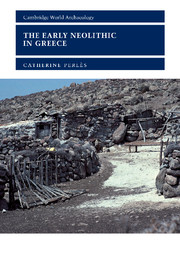Book contents
- Frontmatter
- Contents
- List of figures
- List of tables
- Acknowledgements
- Introduction
- 1 The land and its resources: the geographic context
- 2 The Mesolithic background
- 3 The introduction of farming: local processes, diffusion or colonization?
- 4 Foreign colonists: where from?
- 5 The earliest Neolithic deposits: ‘aceramic’, ‘pre-pottery’ or ‘ceramic’?
- 6 The spread of the Early Neolithic in Greece: chronological and geographical aspects
- 7 A case study in Early Neolithic settlement patterns: eastern Thessaly
- 8 Early Neolithic subsistence economy: the domestic and the wild
- 9 The Early Neolithic village
- 10 Craft specialization: the contrasting cases of chipped-stone tools, pottery and ornaments
- 11 A variety of daily crafts
- 12 Ritual interaction? The miniature world of ‘dolls or deities’
- 13 Interacting with the dead: from the disposal of the body to funerary rituals
- 14 Interactions among the living
- Conclusion
- Bibliography
- Index
8 - Early Neolithic subsistence economy: the domestic and the wild
Published online by Cambridge University Press: 18 December 2009
- Frontmatter
- Contents
- List of figures
- List of tables
- Acknowledgements
- Introduction
- 1 The land and its resources: the geographic context
- 2 The Mesolithic background
- 3 The introduction of farming: local processes, diffusion or colonization?
- 4 Foreign colonists: where from?
- 5 The earliest Neolithic deposits: ‘aceramic’, ‘pre-pottery’ or ‘ceramic’?
- 6 The spread of the Early Neolithic in Greece: chronological and geographical aspects
- 7 A case study in Early Neolithic settlement patterns: eastern Thessaly
- 8 Early Neolithic subsistence economy: the domestic and the wild
- 9 The Early Neolithic village
- 10 Craft specialization: the contrasting cases of chipped-stone tools, pottery and ornaments
- 11 A variety of daily crafts
- 12 Ritual interaction? The miniature world of ‘dolls or deities’
- 13 Interacting with the dead: from the disposal of the body to funerary rituals
- 14 Interactions among the living
- Conclusion
- Bibliography
- Index
Summary
For several decades, the exploitation of domesticated species as potential food resources has been considered a prime – or rather, the prime – factor in the process of Neolithization. This view was recently challenged in the light of archaeological data from the Near East, America and Japan, which suggest that domesticated species were initially too limited in number and scope to have had much dietary importance. In parallel, the relative importance of domesticates in fully developed Neolithic economies has been re-evaluated – and downplayed – in large areas of eastern, central and western Neolithic Europe. Does this mean that the quasiexclusive reliance on domesticated plants and animals, considered a characteristic of Greek Neolithic communities, should also be re-evaluated?
In Greece as elsewhere, taphonomic biases and unequal recovery techniques can lead to widely differing interpretations of the subsistence economy. A debate over the importance of domestic resources in the Early Neolithic of Greece, which were traditionally viewed as predominant, has recently been opened by Björk (1995). Halstead himself, who had defined the economy as typically agro-pastoral in several influential papers which will be largely followed here (Halstead 1977, 1981a, 1984, 1989a), recently argued that the importance of wild resources may have been underestimated due to poor preservation and recovery (Halstead 1989b: 29).
Yet, even if wild resources were locally available, it does not necessarily follow that they were exploited on a large scale. Subsistence economy is culturally based, and must be studied as the expression of social choices within the possibilities offered by the environment and the level of technical development.
- Type
- Chapter
- Information
- The Early Neolithic in GreeceThe First Farming Communities in Europe, pp. 152 - 172Publisher: Cambridge University PressPrint publication year: 2001
- 1
- Cited by



